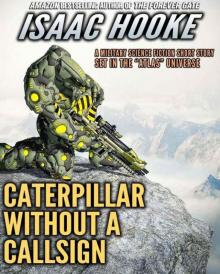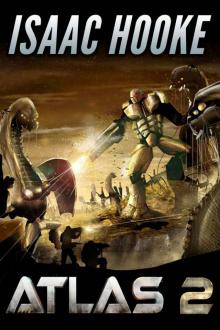- Home
- Isaac Hooke
Forerunner Page 9
Forerunner Read online
Page 9
Jain shut down the feed.
“So, what do we do?” Cranston asked.
“Assuming they’re not holograms, we’re going to retrieve those AI cores.” Jain glanced at Cranston. “No one gets left behind.”
9
Jain redirected one of the transports from the surface of the moon, and when it docked, he steered two specialized rovers aboard. These particular crabs were equipped with grappling arms to handle the AI cores and storage trays to carry them. They also had bigger servomotors, but since there was no gravity aboard the alien craft, there would be no added weight, so the larger servomotors weren’t really necessary.
He landed the transport close to the opening in the alien hull and the ramp opened. The big crabs ambled down onto the disjointed hull, crawling over the pipes; as soon they had cleared the ramp, the original rover, which was waiting outside, climbed up. It paused at the entrance for a decontamination scan, and after a moment the local AI allowed it aboard.
The remaining two rovers proceeded toward the opening in the hull; when they reached it, they entered in single file. Jain watched from the LIDAR-generated viewpoint of the lead unit until its video feed pixelated and froze.
“So that’s that,” Jain said.
“That’s that,” Xander commented. “An idiomatic phrase, indicating that there is nothing more to do or say in regard to a given topic.”
“Thanks for the unasked-for definition,” Jain said.
“Sorry,” Xander said. “I can’t help it, sometimes. I’m an AI.”
“I know.” Jain ordered the transport to return to the moon to help with the ice mining.
By then, Jain and the others had already topped out their propellant supplies, but the Space Machinists had allowed the miners to continue loading ice blocks into the transports on the surface: the starships had room in their storage bays to hold extra supplies for later extraction. Plus, Jain wanted to deliver some of those blocks to Sheila and Gavin, who would need to replenish their propellant levels at some point as well.
Eventually, most of the spare storage bays aboard each starship became full. There were some extra bays available, however because of the way the ships were designed, heat leakage in those compartments would cause the ice to melt, ruling out their use.
So at that point Jain and the others recalled their respective miners. The transports docked, unloading the miners and the final ice block haul.
Then he and the others waited.
He returned a transport to the alien hull, landing it close to the opening. He trained the cameras on the entrance and willed the two rovers to appear.
Shortly thereafter, the two units emerged in single file.
“Well, looks like the AI cores weren’t holograms after all,” Medeia commented.
“No,” Jain agreed.
The rovers carried one AI core each via their storage trays. He watched the two of them crawl back to the transport, which had opened its ramp in invitation.
The two AI cores cleared the decontamination scan, as did the rovers themselves, and the local AI aboard the transport allowed them aboard.
Decon scanned only for biological pathogens, but Jain wanted to be sure that no machine-based entities were hitching a ride either, so once the cores were inside, Jain ran another, more detailed scan via a mobile arm attached to the inside of the transport. He also wanted to confirm that these were indeed AI cores.
“Hm, that’s strange,” Xander said.
“What is it?” Jain asked. He looked at the scan results, which was essentially an X-Ray of the AI core. Everything seemed normal, based on other X-Rays of AI cores he had in his database. He saw the array of interlinked circuit boards that formed the neural networks. They looked like black slabs over a grayish background. There was nothing extra or out of place, at least as far as he could tell.
“Well, the noble gases present in the AI core would ordinarily red shift the scans,” Xander said. “But I’m not seeing any red shift in the results.”
Jain compared the X-Ray to other scans in his database again. He realized Xander was right. The other scans were slightly redder in color.
“So you’re saying the noble gases have been vented?” Jain asked.
“That’s the likely conclusion,” Xander said. “Meaning the AI cores have been opened.”
“Well then, I guess we have nothing to lose by opening them up to confirm the contents,” Jain said.
“I would certainly recommend as much,” Xander said.
Jain swiveled the X-Ray mount aside on the mobile arm and replaced it with a pincer grip mount. He used that to pry open the access panel on the first AI core.
“Did the sensors detect the release of any noble gases?” Jain asked.
“Negative,” Xander said. “As predicted, there were none.”
The arm had a camera and LIDAR attachment, which he directed toward the opening: the interlinked circuit boards inside the AI core appeared on the LIDAR feed at that moment.
“Give me some light,” Jain said.
The shuttle’s inner lighting system activated. The panel offered only a small portal into the inside of the AI core’s cylinder, so Jain moved the camera forward, pressing it into the opening. There wasn’t much room, but he managed to move it from side to side to observe the stacked circuit boards inside.
“Seems legit,” Jain said. “The visuals match up with the external scans.”
He moved the camera deeper and tapped it against one of the circuit boards just in front of the unit. He was met by a solid mass.
“Looks good,” Jain said.
He withdrew the camera, sealed the panel, and repeated the same steps on the other AI core.
“Well, what do you think?” Jain asked.
“There’s not really anything else you can do to confirm the cores are real, short of removing the individual circuit boards,” Xander said.
“Maybe we should do just that,” Mark said.
“You do know that removing even one of the boards could cause irreversible damage to the neural network, right?” Cranston said. “The data would still be accessible, of course, so if that’s all you care about, then by all means do it. But if you want to ensure the Mind Refurbs can boot up, then I wouldn’t do it.”
“No, I won’t risk losing the admiral or the commander by removing any of those boards,” Jain said. “I don’t suppose we can jury-rig a boot up environment aboard the transport, Xander?”
“No, you’ll have to bring them aboard to boot them,” Xander said.
“All right,” Jain said. “Then I guess we’ll have to be satisfied for now.”
He shut the panel and retracted the arm.
The transport closed its ramp and lifted off from the alien hull. It docked with the Talos shortly.
Jain switched to the viewpoint of one of the cameras in the well-lit docking bay. He watched the rovers travel down the ramp and performed a final scan on each unit. Then he handed off the AI cores to the waiting lev trains. Those were small, bucket-like units ordinarily used to convey mined materials to other parts of the ship, such as the refinery, extractor, or storage bays.
In this case, the lev trains conveyed the two AI cores through the tiny winding corridors that composed the inside of Jain’s ship and deposited them in one of the science labs, where a pair of large, robotic arms took over. Those arms placed the AI cores side-by-side on a large table. He intended to perform a backup of the AI cores first, and then after booting them, he’d hook up each core to his VR environment so that he could ask the two captains what the hell had happened back there.
“We’re finally going to find out what’s going on,” Medeia said. “I’m so looking forward to this.”
“We all are,” Jain said. He had shared access to the cameras feeds with the other Space Machinists.
“I’m not,” Cranston said. “But hey, that’s just me.”
“Xander, prepare to flood with noble gases,” Jain said.
If they expec
ted to reboot the cores and reactivate the two Mind Refurbs, those gases were essential: without helium circulating between the boards, the circuitry would shortly overheat and shutdown.
The robotic arms retracted into the adjacent bulkhead, and a glass container descended from the ceiling; it enveloped the table, along with the two AI cores it contained.
“Injecting noble gases,” Xander said.
The gases were colorless, so Jain had no indication they were filling the glass chamber, other than Xander’s word.
“Chamber is full,” Xander announced.
“All right, let’s open them up,” Jain said.
Small arms connected to the table swiveled upward and opened the access panels of each cylinder in turn. The mere act of opening them would cause the gases to flood inside each core, thanks to the pressure differential, and the circuit boards that composed the neural networks would be bathed in the necessary environment.
“Close those panels, and let’s boot them up,” Jain said.
He was viewing the scene from a camera just above the table and could see partly into each open core. As the small arms steered toward the first cylinder, he spotted movement inside the opening.
“Wait!” Jain said. “Something just moved inside the core.”
“Are you sure?” Medeia said.
“Rewind my video feed and take a look for yourself,” Jain said, sharing access. He zoomed in on the opening. “It was like... a flicker.”
The flicker came again.
“There are holoemitters inside,” Jain said. “It’s a trick!”
As he watched, the hidden holoemitters deactivated entirely. The circuit boards still remained in place, however the interconnections between them all vanished.
When the individual units inside began to lose their shape, he realized they weren’t circuit boards at all.
“They’re micro machines of some kind!” Medeia said.
It was obvious now that those micro machines had only joined together in the shape of circuit boards to fool the X-Ray scan, which would have seen right through the holoemitter ruse.
“No shit,” Mark said. “Jain, you might want to jettison those cores!”
To do that, first Jain had to contain the machines. He quickly maneuvered the arms onto the panel of the first core and shut it. He directed the arms to the second core, but it was too late by then—the micro machines were already flooding out. They spilled onto the table like ants and began to... chew.
So much for containment.
“What are they doing?” Mark asked.
“Eating the table,” Cranston said. “Probably making more of themselves.”
More and more ants flowed from the opening, spreading out across the table and eating into the metal.
Jain directed security rovers from across the ship to congregate on the compartment. While he waited for them to arrive, he zoomed in on one of them. It looked vaguely like a block robotic ant. It had a head with mandibles and antennae, a thorax, an abdomen, and twelve segmented legs.
He saw flashes of red light from inside the maw, and realized it was releasing extremely short-range laser pulses to help weaken the metal before the mandibles cut into the surface. At the same time, the insect-like robot utilized a spinneret of sorts on the tip of its abdomen as a miniature 3D-printer: it pulled out red-hot threads from those spinnerets with its hind-legs and overlapped them in organized rows that began to cool. Soon, beneath that abdomen, another ant-like micro machine began taking shape. They were indeed duplicating themselves as Cranston had suggested.
Jain zoomed out. By then, some of the ants had crawled right up to the glass container that bound the table and were exploring the perimeter for vulnerabilities. Others simply began chewing into the glass itself.
The first cylinder dissolved as the micro machines stowed away inside broke free.
“Xander, are these the Banthar termites?” Jain asked.
“Negative,” Xander said. “Humanity has never encountered micro machines of this design before.”
“Yeah, they’re definitely not like the micro machines I have aboard,” Cranston said.
The security rovers Jain had summoned began to arrive outside the compartment. He switched his viewpoint to the cameras in the conduit there.
“What are you going to do?” Cranston said. “That glass container won’t fit into the passageways outside. You can’t transport it.”
“No,” Jain said. “But I chose this particular science lab for a reason. It’s close to the hull.”
The rovers circled the bulkheads outside the compartment, employing their cutting lasers to carve long lines into the top and bottom seams that bordered the overhead and deck respectively. That would weaken the bulkheads for the coming detonation and help direct the explosive gases. Meanwhile, he had other rovers lay demolition charges at equal intervals over those seams: they placed the charges so that the brunt of the detonation would be directed downward, into the seams, rather than into the compartment itself—after all, Jain didn’t want to poke a hole in the chamber and give the micro machines an opportunity to break free before he was done severing that part of himself.
“You’ll never cut the compartment away in time,” Medeia said.
“I have to try,” Jain said. Because if he didn’t, soon his ship, and very AI core, would be nothing but digested and reformed metal.
“Cranston,” Mark said. “If you launched some of your own micro machines and directed them toward the Talos, how fast could your termites cut away the hull section?”
“Not fast enough,” Cranston said. “They’re about as slow as those alien units. Jain’s already doing everything he can, I’m afraid.”
The lead rovers continued to cut into the seams, while those in behind laid the demolition charges. They were split into two groups, with the first group moving along the conduit outside the left-hand side of the compartment, and the second group the righthand side. Each group continued outward until they had circled around the entire compartment and rejoined on the other side.
The rovers hastily retreated in single file into a side conduit, and a blast door closed. Jain activated the blast shields on the cameras outside the compartment, and the view went dark.
Jain detonated the charges, and felt the vibrations pass up and down his midsection, thanks to the tactile subroutines that mapped the ship’s body to his virtual human form. He felt a stabbing pain as well, just behind his belly button.
Xander saw him flinch. “You left your pain sense active?”
Jain nodded. “I want to feel this. I want to remind myself what’s at stake.”
He retracted the blast shields from the cameras in that deck to observe the results. He saw thick black grooves outlining the compartment where the rovers had made their cuts, and the ugly blast craters beside them. Those blast craters exposed the armor beneath the deck—there were still several meters more of it below. And beyond that awaited the actual hull layers. It would take a few more passes yet to penetrate.
Jain opened the blast door and marched the rovers inside to place the next round of charges. As usual, the cutting robots cut grooves into the surface ahead of the others to weaken the area and help direct the blast. Their crab-like legs helped them navigate the ragged edges of the craters.
Leaving them work, he switched to the viewpoint inside of the compartment. The alien micro machines had already eaten through the glass and had moved on to digesting the surrounding deck. They were multiplying at an exponential rate. As usual, some of them were already scouting the perimeters of the compartment, seeking an egress. A few were even climbing the walls: as he watched, one climbed onto the camera lens of his current viewpoint. The camera promptly clicked off.
Jain switched back to the view outside the compartment. More rovers had arrived—these were general-purpose units that he’d conscripted into the security forces. They had collected the entire supply of demolition blocks aboard. Jain would have to find a nitrogen source to
replenish these. Well, or borrow more from the other Space Machinists.
Some of the new rovers joined the others in placing the blocks, while others proceeded to the deck immediately above. When that third group of rovers reached the area directly on top of the compartment, which was composed of several smaller compartments, the robots lasered seams into the bulkheads themselves to direct the flow of the explosive gases into them. Those bulkheads would have to be cut through entirely if the lower section was to separate. Inside those compartments, which were more channels than anything else, were electronic wires and heat sinks—Jain would lose power to certain parts of the deck below, but that could be repaired at a later time.
Meanwhile, on the floor containing the alien termites, the different groups of rovers continued cutting into the deck and placing charges, and when the robots rejoined on the far side, once more Jain sent them scurrying away, this time into two different conduits because of their larger numbers. He shut the blast doors, and then detonated the charges once more. When the group on the deck above finished their work, he did the same with them.
It took two more rounds of that to eat all the way through the hull; since the internal atmosphere wasn’t pressurized, there was no explosive decompression to accompany the breach.
A final blast on the deck above sent the compartment floating downward and out into space. It was painful; feeling like a piece of his midsection had been blow away. And indeed, it had.
The separation occurred none too soon: the termites began to emerge from tiny holes they had carved, and some began to explore along the exterior of the jettisoned chamber, crawling over it like ants emerging from an anthill for the first time.

 Warden 2
Warden 2 Devastator
Devastator Warden 4
Warden 4 Emperor
Emperor Mech
Mech Conqueror
Conqueror Fighter
Fighter The Forever Gate Ultimate Edition
The Forever Gate Ultimate Edition Defiler
Defiler Mech 2
Mech 2 Warden 3
Warden 3 Warden 1
Warden 1 Mech 3
Mech 3 Forerunner
Forerunner The Alliance (AI Empire Book 2)
The Alliance (AI Empire Book 2) Breaker (Monster Tamer Book 1)
Breaker (Monster Tamer Book 1) Bender of Worlds
Bender of Worlds The Pendulum Swings (The Forever Gate Book 8)
The Pendulum Swings (The Forever Gate Book 8) The Link
The Link Just Another Day
Just Another Day Star Warrior
Star Warrior Alien War Trilogy 1: Hoplite
Alien War Trilogy 1: Hoplite Battle Harem 3
Battle Harem 3 The Ethan Galaal Series: Books 1 - 3
The Ethan Galaal Series: Books 1 - 3 Reloaded
Reloaded Robot Dust Bunnies (Argonauts Book 5)
Robot Dust Bunnies (Argonauts Book 5) Battle Harem
Battle Harem ATLAS 3 (ATLAS Series Book 3)
ATLAS 3 (ATLAS Series Book 3) Argonauts 2: You Are Prey
Argonauts 2: You Are Prey Worlds at War (A Captain's Crucible Book 5)
Worlds at War (A Captain's Crucible Book 5) Operation: Bug Spray (Argonauts Book 9)
Operation: Bug Spray (Argonauts Book 9) Battle Harem 2
Battle Harem 2 Redeemed (Bolt Eaters Trilogy Book 3)
Redeemed (Bolt Eaters Trilogy Book 3) Atlas
Atlas Argonauts 1: Bug Hunt
Argonauts 1: Bug Hunt Reactivated (Bolt Eaters Trilogy Book 1)
Reactivated (Bolt Eaters Trilogy Book 1) Alien War Trilogy 3: Titan
Alien War Trilogy 3: Titan Flagship (A Captain's Crucible #1)
Flagship (A Captain's Crucible #1) Caterpillar Without A Callsign
Caterpillar Without A Callsign The Forever Gate
The Forever Gate He Who Crosses Death (Star Warrior Quadrilogy Book 3)
He Who Crosses Death (Star Warrior Quadrilogy Book 3) Reforged (Bolt Eaters Trilogy Book 2)
Reforged (Bolt Eaters Trilogy Book 2) Refurbished
Refurbished Reloaded (AI Reborn Trilogy Book 2)
Reloaded (AI Reborn Trilogy Book 2) He Who Crosses Death
He Who Crosses Death Explorations: First Contact
Explorations: First Contact Planet Killer (A Captain's Crucible Book 4)
Planet Killer (A Captain's Crucible Book 4) Quantum Predation (Argonauts Book 4)
Quantum Predation (Argonauts Book 4) Clandestine-IsaacHooke-FreeFollowup
Clandestine-IsaacHooke-FreeFollowup The Last Stand (The Forever Gate Book 9)
The Last Stand (The Forever Gate Book 9) City of Phants (Argonauts Book 6)
City of Phants (Argonauts Book 6) Test of Mettle (A Captain's Crucible Book 2)
Test of Mettle (A Captain's Crucible Book 2) Cradle of War (A Captain's Crucible Book 3)
Cradle of War (A Captain's Crucible Book 3) Rade's Fury (Argonauts Book 7)
Rade's Fury (Argonauts Book 7) Rebirth (The Forever Gate Book 6)
Rebirth (The Forever Gate Book 6) The Forever Gate Compendium Edition
The Forever Gate Compendium Edition Mechs vs. Dinosaurs (Argonauts Book 8)
Mechs vs. Dinosaurs (Argonauts Book 8) Alien War Trilogy 2: Zeus
Alien War Trilogy 2: Zeus ATLAS 2 (ATLAS Series Book 2)
ATLAS 2 (ATLAS Series Book 2) Operation_Bug Spray
Operation_Bug Spray